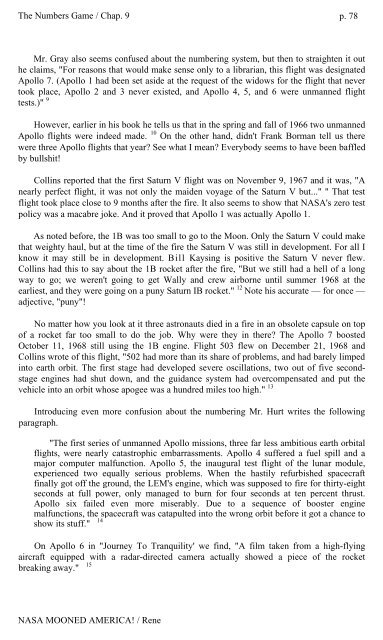Rene-NASA-Mooned-America
Rene-NASA-Mooned-America
Rene-NASA-Mooned-America
Create successful ePaper yourself
Turn your PDF publications into a flip-book with our unique Google optimized e-Paper software.
The Numbers Game / Chap. 9 p. 78<br />
Mr. Gray also seems confused about the numbering system, but then to straighten it out<br />
he claims, "For reasons that would make sense only to a librarian, this flight was designated<br />
Apollo 7. (Apollo 1 had been set aside at the request of the widows for the flight that never<br />
took place, Apollo 2 and 3 never existed, and Apollo 4, 5, and 6 were unmanned flight<br />
tests.)" 9<br />
However, earlier in his book he tells us that in the spring and fall of 1966 two unmanned<br />
Apollo flights were indeed made. 10 On the other hand, didn't Frank Borman tell us there<br />
were three Apollo flights that year See what I mean Everybody seems to have been baffled<br />
by bullshit!<br />
Collins reported that the first Saturn V flight was on November 9, 1967 and it was, "A<br />
nearly perfect flight, it was not only the maiden voyage of the Saturn V but..." " That test<br />
flight took place close to 9 months after the fire. It also seems to show that <strong>NASA</strong>'s zero test<br />
policy was a macabre joke. And it proved that Apollo 1 was actually Apollo 1.<br />
As noted before, the 1B was too small to go to the Moon. Only the Saturn V could make<br />
that weighty haul, but at the time of the fire the Saturn V was still in development. For all I<br />
know it may still be in development. Bill Kaysing is positive the Saturn V never flew.<br />
Collins had this to say about the 1B rocket after the fire, "But we still had a hell of a long<br />
way to go; we weren't going to get Wally and crew airborne until summer 1968 at the<br />
earliest, and they were going on a puny Saturn IB rocket." 12 Note his accurate — for once —<br />
adjective, "puny"!<br />
No matter how you look at it three astronauts died in a fire in an obsolete capsule on top<br />
of a rocket far too small to do the job. Why were they in there The Apollo 7 boosted<br />
October 11, 1968 still using the 1B engine. Flight 503 flew on December 21, 1968 and<br />
Collins wrote of this flight, "502 had more than its share of problems, and had barely limped<br />
into earth orbit. The first stage had developed severe oscillations, two out of five secondstage<br />
engines had shut down, and the guidance system had overcompensated and put the<br />
vehicle into an orbit whose apogee was a hundred miles too high." 13<br />
Introducing even more confusion about the numbering Mr. Hurt writes the following<br />
paragraph.<br />
"The first series of unmanned Apollo missions, three far less ambitious earth orbital<br />
flights, were nearly catastrophic embarrassments. Apollo 4 suffered a fuel spill and a<br />
major computer malfunction. Apollo 5, the inaugural test flight of the lunar module,<br />
experienced two equally serious problems. When the hastily refurbished spacecraft<br />
finally got off the ground, the LEM's engine, which was supposed to fire for thirty-eight<br />
seconds at full power, only managed to burn for four seconds at ten percent thrust.<br />
Apollo six failed even more miserably. Due to a sequence of booster engine<br />
malfunctions, the spacecraft was catapulted into the wrong orbit before it got a chance to<br />
show its stuff." 14<br />
On Apollo 6 in "Journey To Tranquility' we find, "A film taken from a high-flying<br />
aircraft equipped with a radar-directed camera actually showed a piece of the rocket<br />
breaking away." 15<br />
<strong>NASA</strong> MOONED AMERICA! / <strong>Rene</strong>


